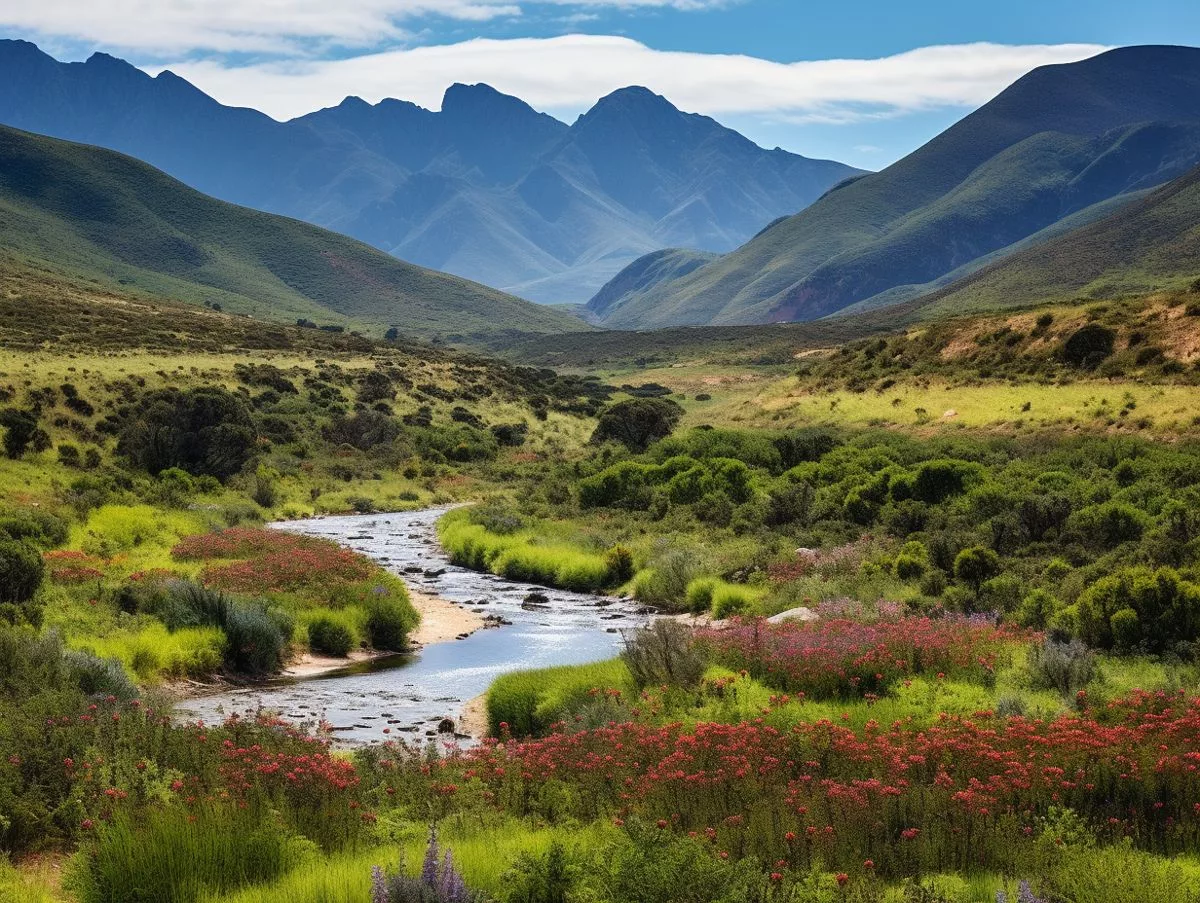Take a self-driving road trip across South Africa and visit 19 national parks with stunning landscapes and diverse wildlife. Witness conservation success stories and explore unique ecosystems on this journey of over 7,000 km. This pilgrimage for nature lovers offers a chance to discover South Africa’s natural wealth, conservation efforts, and the balance between humans and the environment.
South Africa’s Scenic Splendor: A Road Trip through 19 National Parks
Embark on a 7,260 km self-driving adventure across South Africa, visiting 19 national parks with breathtaking landscapes and diverse biodiversity. Witness conservation success stories and explore unique ecosystems. This road trip is a pilgrimage for nature lovers, offering a unique opportunity to discover South Africa’s natural wealth, conservation efforts, and the balance between humans and the environment.
Embarking on an Adventure
Travelling is a passion that manifests itself in various forms. Some individuals journey for work, while others seek leisure. However, a special group of daring adventurists travels with the goal of curating their own unique experiences. This unique clan includes nature buffs and park-hoppers, who find comfort in wilderness and see an investment in the adventure. This piece is formulated for these individuals, providing a guide for newcomers and focusing on an awe-inspiring circuit across South Africa, a land gifted with picturesque natural endowments.
The trip starts from Johannesburg, extending over a whopping 7260 km. It covers the breezy coastlines, the desolate stretches of the Karoo, and the lush environment of the Garden Route. The liberty of self-driving opens up the potential for spontaneous detours and alterations, injecting a personal touch into the journey.
An Exploration of Biodiversity
The journey commences with the first stop at Golden Gate Highlands National Park, nestled in the northeastern Free State. The foothills of the Maluti Mountains present captivating panoramas, as their sandstone cliffs glisten golden under the sun rays. The park showcases an exceptional biodiversity, with rare species such as the bearded vulture and the bald ibis.
The journey progresses into the Northern Cape, to the Mokala National Park. Amid the harsh surroundings, the park is a beacon of life, home to the sturdy camel thorn and a variety of relocated wildlife. Among them are black and white rhinos, tsessebe, and roan antelope.
Upon reaching the Karoo, travellers encounter the Camdeboo National Park. The awe-inspiring beauty and distinctive ecosystem of the park serve as a testament to the natural richness of the country. A short detour to the historic town of Graaff-Reinet or the nearby Valley of Desolation introduces a local touch to the journey.
Witnessing Conservation Success
The next halt in this voyage is the Mountain Zebra National Park in Cradock. An encouraging tale of conservation success, the park, which once nearly lost its zebras to extinction, now boasts a population of 370 zebras. Other inhabitants of the park include black rhino, eland, and Cape buffalo.
The Addo National Park offers visitors a chance to witness the world’s largest animal- the elephant. Once housing a mere 11 elephants in the 1930s, the park now serves as a sanctuary for over 450 elephants. This provides the densest elephant population on the planet. The park is also home to the iconic black-maned lions of the Kalahari, introduced to the park due to their disease-free status.
The Garden Route National Park, a verdant coastal reserve, presents a diverse experience with its beautiful beaches, rugged coastlines, and indigenous forests. The park provides multiple means to explore its scenic beauty, including on foot, by kayak, lilo, boat, mountain bike, scooter, or Segway.
The Final Leg of the Journey
Resuming the journey towards the interior, the Karoo National Park offers a stark contrast to the coastal lushness. Dominated by the Nuweveld Mountains, the park is home to the world’s highest density of tortoise species.
The Tankwa Karoo National Park, a must-visit spot, is home to spectacular sunsets and a wide variety of succulent plants. One of only two southern African regions recognized as Biodiversity Hotspots by Conservation International, it’s a haven for nature enthusiasts.
The journey then proceeds to Bontebok National Park. Set against the majestic Langeberg Mountains, the park is a beacon of successful conservation, with the population of its namesake, the Bontebok, increasing from 17 to around 3,000.
The journey continues to Agulhas National Park, where two oceans meet at the southernmost tip of Africa, a blend of historic lighthouses, rugged coastlines, shipwrecks, and the serene sound of crashing waves.
The tour reaches a midpoint with Table Mountain National Park. The iconic penguins at Boulders Beach and the panoramic views from Cape Point are highlights. The breathtaking views from the peak of Table Mountain provide an opportunity to pause, reflect, and prepare for the next leg of the journey.
The Journey’s End
After visiting the West Coast National Park, known for its vibrant display of daisies, and Namaqua National Park, home to the world’s richest bulb flora, the journey enters its final stages. The Richtersveld Transfrontier National Park, jointly managed by the local Nama people and the South African National Parks, showcases the world’s richest desert flora.
The grand finale of the journey, Kruger National Park, is home to an impressive variety of species and is a world leader in advanced environmental management techniques and policies.
This journey, similar to a pilgrimage for nature lovers, traverses landscapes, biodiversity, and history in a country as diverse as its national parks. It presents a unique opportunity to discover South Africa’s natural wealth, its conservation efforts, and the delicate balance between humans and the environment. This road trip is an adventure, a discovery, and a testament to the undying human love for nature and exploration.
1. What is the South Africa’s Scenic Splendor road trip?
The South Africa’s Scenic Splendor road trip is a 7,260 km self-driving adventure across South Africa, visiting 19 national parks with breathtaking landscapes and diverse biodiversity.
2. Who is this road trip for?
This road trip is a pilgrimage for nature lovers, offering a unique opportunity to discover South Africa’s natural wealth, conservation efforts, and the delicate balance between humans and the environment.
3. What kind of ecosystems and wildlife can be explored on this road trip?
Travellers can explore unique ecosystems and witness rare and endangered species, including the bearded vulture, bald ibis, black and white rhinos, tsessebe, roan antelope, and the world’s largest animal, the elephant.
4. What are some of the conservation success stories that can be witnessed on this road trip?
Many of the national parks on this road trip have conservation success stories, such as Mountain Zebra National Park, which now boasts a population of 370 zebras after nearly losing them to extinction. Addo National Park also serves as a sanctuary for over 450 elephants, which provides the densest elephant population on the planet.
5. What are the highlights of the road trip?
The road trip covers the breezy coastlines, the desolate stretches of the Karoo, and the lush environment of the Garden Route, and presents a unique opportunity to discover South Africa’s natural wealth, its conservation efforts, and the delicate balance between humans and the environment. Highlights include the iconic penguins at Boulders Beach, the panoramic views from Cape Point, and the breathtaking views from the peak of Table Mountain.
6. What is the final destination of the road trip?
The grand finale of the journey is Kruger National Park, home to an impressive variety of species and a world leader in advanced environmental management techniques and policies.












